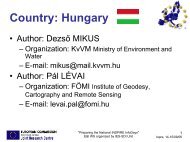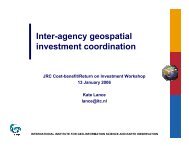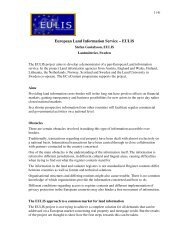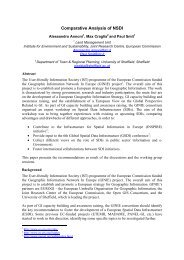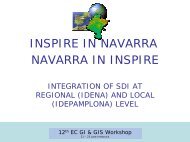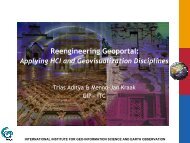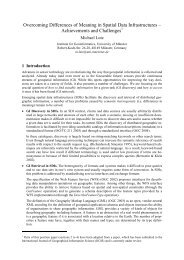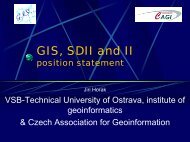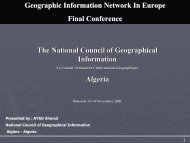session - EC GI & GIS Portal
session - EC GI & GIS Portal
session - EC GI & GIS Portal
Create successful ePaper yourself
Turn your PDF publications into a flip-book with our unique Google optimized e-Paper software.
SESSION PEER GROUP<br />
European Environment Agency SDI – progress and plans to support the<br />
implementation of a shared environmental information system<br />
M.P. Lund, J. Bliki, A. Sousa, M. Erhard, T. Jessen, C. Steenmans<br />
European Environment Agency, Copenhagen, Denmark<br />
The concept of the spatial data infrastructure (SDI) proposal for the European Environment Agency (EEA)<br />
was drafted in 2002. Since then, EEA has gradually implemented the different components of its SDI, in line<br />
with the visions from Agenda 21, the Global Spatial Data Infrastructure Association and the INSPIRE<br />
proposal.<br />
EEA focuses on the production, dissemination and quality assurance of environmental thematic geospatial<br />
datasets to support integrated assessment and reporting on Europe’s environment. Priority is given to transboundary<br />
issues. A number of services are provided spanning from metadata discovery over geospatial view<br />
services to download facilities, in line with the vision and principles of INSPIRE.<br />
For a number of years the EEA dataservice at http://dataservice.eea.eu.int/ has been the place where all<br />
datasets compiled or used by EEA are stored, geospatial as well as tabular data. Analytical products like maps<br />
and graphs are also stored here. Metadata are published for each dataset, map or graph and a download facility<br />
is available. A quality label based on ISO19113/4 reporting was recently introduced for European datasets<br />
produced by EEA. The EEA dataservice serves both as an archive internally and as a discovery and download<br />
service for its users, i.e. the European Information and Observation Network (EIONET), European<br />
Commission and Parliament, the public, etc. The dataservice is widely used with at present on average 6000<br />
downloads per month for geospatial datasets alone. Still improvements on metadata and user friendliness can<br />
be achieved.<br />
The EEA metadata standard for geographic information (EEA-MS<strong>GI</strong>) has been in operation for three years<br />
now. The MS<strong>GI</strong> is a profile of ISO 19115 and along with an EEA metadata editor and a metadata tool package<br />
it supports the documentation of workflows of geospatial data handling at EEA. Improvements that would<br />
allow for the XML-based metadata to be discovered independently of the metadata provided on EEA<br />
dataservice would need further development.<br />
Since December 2004 prototype view services have been developed. The success of these web map viewers<br />
comes from a tool box concept developed by EEA that allows re-use of the same standard components in<br />
different map services. Thereby the user requirements have been separated from the technology which is a<br />
huge advantage for developing and maintaining the services. The toolbox includes customized layout and<br />
querying. In the longer perspective harmonized tools for analyses will be added. In 2003 EEA had five<br />
operational view services. In 2006 it will be more than 30 operational services. The view services are<br />
developed to facilitate access to environmental information related to nature, emissions, land cover, air quality,<br />
water, etc., and they rely on high quality, harmonised European data that are related to core geographic<br />
reference data.<br />
Direct access to geospatial data between EEA, based in Copenhagen, and its European topic centre on<br />
terrestrial environment, based in Barcelona, has been installed as a first step towards distributed information<br />
management. The advantages of improved data management, maintenance and exchange are manifold, but<br />
poses at the same time new challenges regarding versioning standards and notification services.<br />
Key EEA products and services such as the recent ‘The European environment - State and outlook 2005’<br />
report, the indicator management system, the reporting mechanisms on sectors and environment (i.e.<br />
agriculture, transport, energy) are more and more using SDI as the backbone for data and information<br />
management. These concrete products and services helped EEA to overcome most of today’s technical<br />
challenges for implementation of a spatial data infrastructure and are paving the way towards an operational<br />
shared environmental information system in Europe.<br />
Papers, documentation and tools for geospatial data and SDI developed by EEA are available from<br />
www.eionet.eu.int/gis.<br />
14



